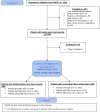Incidence, demographics and rehabilitation after digital nerve injury: A population-based study of 1004 adult patients in Sweden
- PMID: 37027435
- PMCID: PMC10081734
- DOI: 10.1371/journal.pone.0283907
Incidence, demographics and rehabilitation after digital nerve injury: A population-based study of 1004 adult patients in Sweden
Abstract
Objective: The main objective of this study was to describe the epidemiology of surgically repaired digital nerve injuries in a Swedish population. Secondary objectives were to describe the demographics of the patient population, injury characteristics, post-operative care and rehabilitation.
Methods: From 2012 to 2018, 1004 patients with a surgically repaired digital nerve injury resident in the Stockholm region were identified in the Swedish national quality registry for hand surgery and all medical records were thoroughly reviewed.
Results: The incidence rate was 8.3 per 100.000 person-years and these injuries were more common in men than women. The median age at the time of injury was 37 years and a sharp cut was the most common mechanism of injury. Injuries were equally distributed over weekdays and the year, but surgery was most often performed on Mondays. There were no differences in treatment and rehabilitation regimens between sexes, except women were more likely than men to be operated within three days from injury. Timing and content of rehabilitation varied largely between individuals. One third of patients did not receive any sensory relearning and sensory assessment was performed in only 7%.
Conclusion: The epidemiology shows no major changes over the last decade. However, we found a large individual variation in follow up visits, rehabilitation content and assessments indicating large differences in consumption of health care resources. Our findings expose the need to further improve and evaluate rehabilitation regimens after digital nerve injury.
Copyright: © 2023 Evertsson et al. This is an open access article distributed under the terms of the Creative Commons Attribution License, which permits unrestricted use, distribution, and reproduction in any medium, provided the original author and source are credited.
Conflict of interest statement
NO-The authors have declared that no competing interests exist.
Figures







